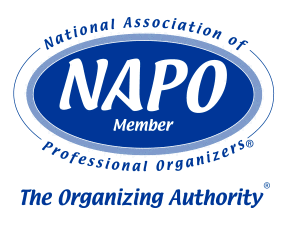 People are passionate about the good stewardship of the environment and every spring we celebrate the outdoors with special focus on how to take better care of nature and the world around us. Earth Day is celebrated with fun runs, outdoor art projects, book and clothing swaps, recycle events, environmental clean-up work parties, educational events focused on green living and environmental sustainability, and much, much more.
People are passionate about the good stewardship of the environment and every spring we celebrate the outdoors with special focus on how to take better care of nature and the world around us. Earth Day is celebrated with fun runs, outdoor art projects, book and clothing swaps, recycle events, environmental clean-up work parties, educational events focused on green living and environmental sustainability, and much, much more.
Earth Day is April 22, but at Organize to Simplify we celebrate the spirit of Earth Day every day!
As a Professional Organizer and proud member of the National Association of Professional Organizers (NAPO), my goal is to use my experience and training to develop physical and thought processes to re-purpose a client’s home or office to better suit their needs. The true purpose of a Professional Organizer is manifested when a client takes what we learn in our one-on-one organizing sessions and transfers those skills to other areas of their lives. Besides teaching the organization process, we teach clients about recycling, reusing, and overall reducing the impact of de-cluttering on our environment.
One of the most frequent questions during a consultation or organizing session is “what do I do with all this stuff I don’t need any more but is still usable?” The answer is pretty simple . . . “sell, give, recycle, or donate.”
SELL: If you believe someone will pay you for it, give selling it a shot. If it hasn’t been sold in 30 days, move it to a “GIVE” or “DONATE” pile. Note: Caution should be used when selling items to ensure that personal and financial precautions are taken.
GIVE: If you know someone that can use the item, label it with that person’s name and a date (usually 30 days from an organizing session). If in those 30 days, the item hasn’t made it to the new owner, it goes into a “SELL,” “RECYCLE,” or “DONATE” box.
RECYCLE: Anything that is no longer usable that can be recycled should be recycled. Many times I’ve carted away old papers, cardboard boxes, old jars, plastic containers, paper and plastic grocery bags, etc. to be recycled instead of being designated “garbage” and sent to the landfill.
DONATE: This is my favorite and I use it with every organizing session. Many of my clients never thought about the social impact of recycling their clothes and household items to an appropriate charity, be it a school, church, thrift store, or many other 501c3 organizations.
As my Mission Statement explains, at Organize To Simplify I “will provide a thoughtful and thorough analysis of a client’s needs, endeavoring to realize their goals of a more organized and peaceful environment. Together we can help others and the environment by reducing, re-purposing, and recycling items you no longer need to lessen the long-term impact on our environment.”
Let’s all do whatever we can to reduce, reuse, recycle, replenish, and restore . . . not just on Earth Day, but every day.
Cindy Jobs
Proud member of:
 National Association of Professional Organizers (NAPO), Seattle Area Chapter President
National Association of Professional Organizers (NAPO), Seattle Area Chapter President
 Institute for Challenging Disorganization (ICD)
Institute for Challenging Disorganization (ICD)

